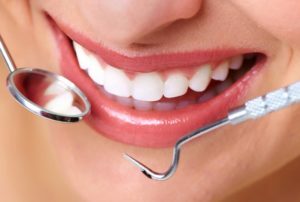 Inflammation of the gums in the absence of timely treatment can lead to serious complications. How to choose the right therapy, and what medicines should be used first?
Inflammation of the gums in the absence of timely treatment can lead to serious complications. How to choose the right therapy, and what medicines should be used first?
Most people suffer from gum disease. Depending on the nature of the inflammatory process and the degree of severity, there may be various symptoms - from minor redness to swelling, bleeding, painful erosions.
Treatment should be started at an early stage of the disease, referring to a qualified consultation with the dentist.
As a rule, competent selected therapy implies a complex of measures, among which the reception of antibiotics and inhibitory inflammatory processes of preparations are of primary importance.
Contents
- Causes of inflammation
- Causes of inflammation
- Treatment with antibiotics
- Injections of antibiotics in the gums
- Anti-inflammatory drugs of local action
- Preventive measures
Causes of inflammation
Inflammation of the gums causes bacteria that are present in the plaque on the oral mucosa and are activated in favorable conditionsnot always associated with inadequate oral hygiene):
-
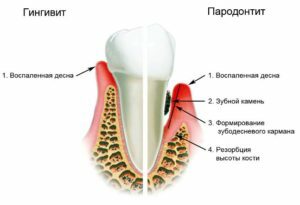 gum tissue injury by a filling or edge of the crownand;
gum tissue injury by a filling or edge of the crownand; - abnormality of the gums due to dental manipulation;
- chronic periodontitis in the acute stage;
- teething wisdom;
- lack of minerals and vitamins in the body;
- diseases of the digestive tract, blood vessels and heart;
- malfunction of the immune system;
- presence in the history of diabetes mellitus or hormonal disorders;
- taking a number of medications, including vasoconstrictive drops and antidepressants;
- smoking;
- genetic predisposition.
Now we'll figure it out than treat gum disease most effectively.
Effective treatment of various forms of gingival inflammation:
Treatment with antibiotics
In most cases, the treatment of inflammatory processes in the oral cavity implies the mandatory intake of antibacterial drugs due to general intoxication of the body.
A specific medicine can be prescribed only by a doctor, focusing on the patient's condition. In this case, both tableted or encapsulated forms and solutions can be selected. The latter are usually used in the form of rinses. The most commonly prescribed antibiotics are
- Metronidazole .This drug is an auxiliary antibiotic, so it is not taken alone, but used in
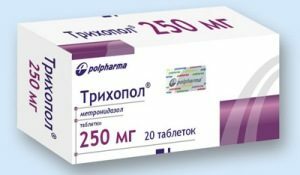 combinations with other antibacterial agents( possible options will be discussed below).The course of treatment is usually about 10 days with a three-time intake during the day. Children Metronidazole( Trichopol) can be appointed only in an extreme situation, when the effect exerts over the possible risk.
combinations with other antibacterial agents( possible options will be discussed below).The course of treatment is usually about 10 days with a three-time intake during the day. Children Metronidazole( Trichopol) can be appointed only in an extreme situation, when the effect exerts over the possible risk. - The glycosamide group .These include Lincomycin and Clindamycin. The first drug is issued in the form of capsules( taken 3 times a day) and a solution for intramuscular injection( twice a day).The course of treatment is 10 days. The disadvantage of Lincomycin is its narrowly directed antimicrobial effect, as a result of which the disease can manifest itself again. In addition, when taking the drug in capsules often develops the dysbacteriosis of the gastrointestinal tract. Clindamycin is produced in forms similar to the previous preparation, but it has less irritating effect on the stomach and intestines, effectively destroying the pathogenic
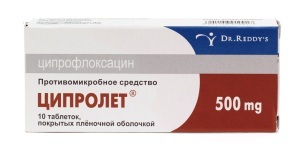 bacteria. The standard is a 10-day course of treatment.
bacteria. The standard is a 10-day course of treatment. - Fluoroquinolones group .As a rule, such tablets are prescribed for periodontitis, if a history of the patient has diabetes mellitus or the immunity of other groups of antibacterial agents is diagnosed.7-or 10-day therapy can be performed using Nomycin( norfloxacin), Cyprolet( ciprofloxacin), or Tariwida( ofloxacin).Tablets are drunk twice a day.
- Penicillin group .The main drugs are Amoxicillin and Augmentin. In a suitable dosage, the bactericidal action of Amoxicillin can be administered to both adults and children. The duration of the course is from 7 to 10 days, 2 tablets per day. Take the drug before the end of the course is necessary even with an earlier disappearance of the symptoms of inflammation. Augmentin refers to semi-synthetic antimicrobial antibiotics and consists of a combination of Amoxicillin and clavulanic acid, due to the presence of which an effective blocking of microbial enzymes is provided.
Injection of antibiotics into the gum
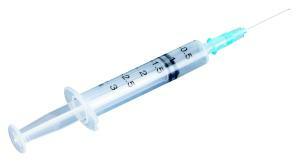 Today, this method of treating gum disease is not applied because of significant harm to the body. Antibiotics for inflammation of the gums and teeth can be administered only intramuscularly and in no other way, despite the apparent effect of this treatment( reduction in bleeding, elimination of pain syndrome, removal of edema).
Today, this method of treating gum disease is not applied because of significant harm to the body. Antibiotics for inflammation of the gums and teeth can be administered only intramuscularly and in no other way, despite the apparent effect of this treatment( reduction in bleeding, elimination of pain syndrome, removal of edema).
This categorization is due to the consequences that entails the introduction of an antibiotic directly into the tissues of the gums and bone.
Because of the high level of antibacterial agent concentration, the maximum amount of pathogenic flora is instantly destroyed, which, simultaneously with the improvement of the condition, leads to the release of toxins and cytokines that mediate inflammation and subsequent necrosis of tissues.
Anti-inflammatory drugs of local action
Than it is possible to remove the inflammatory process:
- Metrogil denta .The drug in the form of a gel is prescribed for various types of inflammation of the gums. Before application,
 requires preliminary cleaning of the oral cavity from plaque and calculus, otherwise the effectiveness of treatment is reduced. In the morning( after breakfast) and in the evening( before bedtime), a thorough oral hygiene is carried out, followed by rinsing with an aseptic solution, after which the gums are well dried with a gauze swab. Apply a small amount of gel to the affected areas with a finger. You can eat and drink only after 2 hours.
requires preliminary cleaning of the oral cavity from plaque and calculus, otherwise the effectiveness of treatment is reduced. In the morning( after breakfast) and in the evening( before bedtime), a thorough oral hygiene is carried out, followed by rinsing with an aseptic solution, after which the gums are well dried with a gauze swab. Apply a small amount of gel to the affected areas with a finger. You can eat and drink only after 2 hours. - Gel Asepta .Can be used for both treatment and prevention. The composition contains carboxymethylcellulose and pectin. Anti-inflammatory gel for gums provides effective anesthesia and is quickly fermented on the gums, fixing on their surface for a period of at least half an hour. As a result, pathogenic microbes are effectively eliminated, the gums cease to bleed, their tissues are strengthened. The harmful flora disappears not only on the gums, but also between the teeth. Also, there is a decrease in sensitivity when eating hot or cold food. Before use, clean the oral cavity and dry the gums, then apply a thin layer of gel on the finger. Frequency
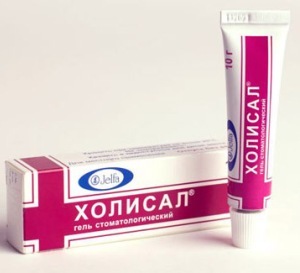 use - 2 times a day. You can consume food and drink after 60 minutes. Sometimes after use in the mouth appears a slightly pronounced metallic taste.
use - 2 times a day. You can consume food and drink after 60 minutes. Sometimes after use in the mouth appears a slightly pronounced metallic taste. - Gel Holispal .Can be used at any age( cautiously prescribed for children up to a year), providing effective antimicrobial, antifungal, anti-inflammatory and analgesic effect. The composition contains cetalkonium chloride, choline salicylate. Before using the drug, it is important to eliminate the cause of inflammation by conducting deep cleansing of the oral cavity, in order to avoid the transition of the process into a chronic sluggish form. An anti-inflammatory gel for gums is applied twice a day after brushing teeth, rinsing the mouth with an antiseptic solution and drying the gums. Two minutes after the application the pain sensations are eliminated, the effect lasts up to 8 hours. Minor discomfort during the treatment can be associated with increased salivation after applying the gel( actively secreted saliva can be swallowed).Eating is allowed after 2 hours, and drinks - after 30 minutes.

- Kamistad .This tool in the form of gel for gums is indicated for use by children over 12 years of age and adults. The active ingredients are lidocaine hydrochloride and chamomile, which provides local anesthesia, wound healing and antiseptic action. Use Kamistad follows the same procedure as the previous preparation, pre-cleaning the oral cavity and drying the gums.
Preventative measures
As already noted, even with qualitative regular oral hygiene, the risk of gum disease is still present due to a number of factors beyond the control of a person. To minimize the risk of inflammation, it is enough to observe the following rules:
-
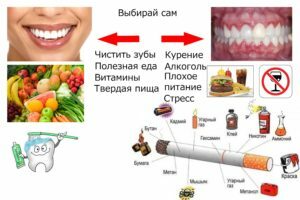 The daily diet should contain foods rich in vitamin C and calcium - herbs, dairy products, nuts, fish. This menu helps strengthen teeth and gum tissue, protecting them from bleeding.
The daily diet should contain foods rich in vitamin C and calcium - herbs, dairy products, nuts, fish. This menu helps strengthen teeth and gum tissue, protecting them from bleeding. - If possible, should eliminate the harmful habits of in the form of drinking alcohol, smoking and leading a healthy lifestyle.
- Every day, you should devote sufficient time to oral hygiene ( cleaning the teeth in the morning and in the evening should be completed by treating the spaces between the teeth with a floss after each meal).
